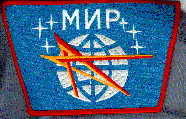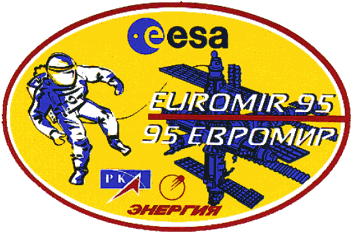
MIRWATCH
by Ben Huset
October '95

Yuri Gidzenko, Thomas Reiter and Sergei Avdeyev
The C.I.S. manned space station Mir with Mir-20 (call sign 'Uran') Cosmonauts
Yuri Gidzenko, Sergei Avdeyev and Thomas (DF4TR / DP0MIR) Reiter and will be
appearing in the mid-western US pre-dawn skies September 20th to October 10th.
and then re-appearing in the evening skies October 15th to November 6th, 1995.
Amateur radio operators can log into the Mir 'Packet' (R0MIR-1) BBS on 145.550
simplex and 437.775 downlink / 435.775 uplink MHz. The cosmonauts also use
this freqs. 145.200, 145.550, 145.800 145.850 to talk with amateur radio
operators on the ground during their off-hours. The 70 cm equipment, SAFEX II,
will be installed during the mission. It is capable of FM voice and FSK 9600
Baud packet modes on 437.925, 437.950, and 437.975 MHz
For exact times and locations to see the space station over your backyard call
MN MIRWATCH Coordinator Ben Huset at (612) 639-9109. This info is also
available on the MN SFS computer BBS at (612) 459-0892 (300-14,400 baud).
Look for MIRWATCH and other great space stuff on my web page at
http://www.skypoint.com/members/benhuset/
For those with WWW access on the internet I highly recommend that you check out
http://www.op.dlr.de/EUROMIR95
maintained by George Hiendlmeier of DLR in Germany. Good Job, George!
This web site includes daily Mir status reports, pre-launch images of the
Mir-20 Crew, EuroMir '95 patch and descriptions of the 47 ESA experiments,
with more to come.
Here are some clips from the EUROMIR '95 web pages...

The launch of the Russian SOYUZ spacecraft, carrying the European (German)
Astronaut Thomas Reiter and two Russian Cosmonauts (Yury Gidzenko and Sergei
Avdeev) to the MIR Station has occurred on 3rd of September 95
The docking to the MIR Station complex was on the 5th of September and the
contact between the two spacecraft occurred at 12:29:54 CET , the crew has
opened the hatch at 13:01:12 CET and the crew of SOYUZ TM 22 and MIR joined
in orbit. Thomas Reiter was first followed by commander Gidzewnko and
Engineer Avdeev. Presents were exchanged. Thomas brought an ESA Flag and
the EuroMir 95 decal. The crew then staged for a video conference with the
control center.
ACTUAL MISSION STATUS:
(from the desk of the Payload Operations Manager)
FLIGHT DAY 016 / 18:30 CET (18 September 1995)
The crew on-board MIR is in excellent condition and had a regular working day
again after the rest on Sunday. Generally the weekends remain free of any
scheduled experiment activities. They are used only in exceptional cases -
that is if the program of the preceding week could not be completed or some
trouble shooting may be necessary. Also Public Relations events brake this
rule.
The crew has a chance to talk to their families yesterday, a weekend activity
that is enjoyed by both, the crew men and the families - as you can imagine.
This contact is off the records and not monitored by ground personal of
course.
Today's experiments included the T-4, T-8, VTS, 38-D and 18-D.
A day on-board MIR usually starts at 08:00 ZUP time (SCET+1) when the crew
is woken up by a alarm clock. After a period for checkout of the MIR systems,
the crew then has time allocated for their morning toilet, followed by
breakfast. This time is sometimes overlaid by experiments involving the
human body as a subject.
Depending on the actual orbit of the station, there are ground contacts to
various Russian ground stations (and sometimes relay-satellites). These
contacts are used to exchange verbal information between the ground personal
and the crew, including information's about their medical status as well as
personal matters and in majority information about the experiments to be set
up or are presently conducted.
The working day (the crew nominally works 5 days per week and has two weekend
days for free disposal) is then filled by experiments, station maintenance
and physical exercise. Lunch is scheduled for mid-day and the dinner is
usually around 20.00.
After dinner the crew has time for personal disposal and the night (sleep)
on-board starts at 23.00.
---(end of EuroMir '95 clips)---
Here are some upcoming events aboard Mir:
Saturday October 7th,"Space: fiction and real". During the Space Festival
taking place at Disneyland Paris, over 500 children from all ESA member states
and Russia will spend a morning at a "space class" with specialists from the
worlds of space and fiction, culminating in a live link-up with the crew on
board Mir.
Friday October 20, 1995 "EVA day by the ESA astronaut" Beginning at 13:00 hrs
Moscow time, with a planned duration of 5 hours.
Thursday November 2, 1995 "Launch of STS-74 " at 11:25am EST docking at Mir 3
days later.
Thursday November 9th"Art & education"
Twenty works of art selected after a worldwide contest (Ars ad Astra project)
will be 'exhibited' both in the Mir station and at the Euro Space Center in Belgium,
from where a live link and discussion with the crew will be organized for European
children accompanied by some of the artists on the theme "Space and Humanity".
Tuesday January 16, 1996 "Landing Mir-20" (13:36 hrs Kazakhstan time)
In Other Recent Russian Space News...
POWER TO PLESETSK CUT OFF. Regional power authorities cut off the power to the
Plesetsk Rocket Launch complex on September 15th because the Strategic Missile Forces
had not paid their electric bill. They are using backup-up emergency power systems to
remain functional. The missile forces are said to owe the power authorities a total of
73 billion rubles ($17 million), of which 17 billion rubles ($4 million) is Plesetsk's debt.
SOYUZ TM-21 LANDS The crew of the 19th Main Exp. to MIR, Solovyov and Budarin,
made a safe landing in Kazakhstan, 302 KM NE of Arkalyk on September 11, 1995 at 06:52
UTC. The Soyuz-TM-21 came down 'far away from the aiming point'. The rescue parties found
the crew in an excellent condition. I have yet to hear as to WHY, they came down off course.
Altair Problems European Mir watcher Chris v.d. Berg reports Altair (Cosmos-2054):
geostationary satellite is in use for communications between TsUP and MIR, but the Russians
do not use it during all possible 'windows'. The satellite is also not as 'stationary' as it
should be: The orbital inclination is more than 3 degrees and is still increasing. To keep
the satellite in sight it is necessary to adjust the elevation and azimuth of the receiving
dish-antenna regularly. Another problem arose on July 25, 1995: The engineering beacon of
the satellite transmitting on 11.380 GHz disappeared and has not resumed since. The beacon
signal had enabled observers to maintain the direction of their dish antenna. Without that
beacon it is still possible to find the Altair transmissions for TsUP-MIR communications on
10.830 GHz, phone transmissions as well as television images, by turning the dish antenna to
the 'calculated' direction during 'windows', when MIR and Altair see each other.
On August 18,1995 Mir TV showed a disoriented salamander that was hopelessly struggling
to find her way. It was obvious that the poor creature was not able to this without gravity..
After the salamander had been put in a container by Budarin, the cosmonauts showed other
images of the exterior of the complex: the modules, the ships and some solar arrays.
FROM COSMONAUTS TO COFFINS. Dnepropetrovsk's Yuzhmash factory will now produce
coffins instead of space ships, Pravda reported August 22. The new coffins will be made
of pressed cardboard to keep costs down, but will be every bit as reliable as the space
equipment the firm used to make, its officials said.
Art Dula is now selling Soviet Space artifacts on the web. at
http://www.dula.com/Russia_House/ '...This site contains a wide selection of
Soviet/Russian Space Program memorabilia and hardware. We invite you to browse the list
of merchandise, which includes short descriptions, pictures, and pricing. We've sorted
the listing into subject categories for your convenience. Feel free to contact us with
any questions...'
Clip from 'Novosti Kosmonavtiki' No.8, 1995, p.42
Gennadiy Strekalov flew his recent mission onboard of Soyuz TM-21/STS-71 after
resigned from Energia corps on January 17, 1995.
He had resigned due to his age, but since he signed a contract with Russian Space
Agency on Soyuz TM-21 flight, he flew the mission not being a member of cosmonaut corps!
Strekalov was assigned to position of Head, Department No. 291 of NPO Energiya on
January 17, 1995, right after his formal departure from Energiya cosmonaut corps.
All Energiya cosmonauts except Krikalyov formally worked in that department.
During Strekalov's flight on Mir his responsibilities were temporarily carried out by
Aleksandr Kaleri. Since there is no chief cosmonaut position at Energiya, the head of
department no. 291 position is equivalent to Energiya's chief cosmonaut.
-30-
Editors & e-mail readers
Surf more about it. Check out these sites
Return to:  October Downrange
October Downrange
Send Comments/Suggestions on this page to BenHuset@SkyPoint.com
Last Updated: Oct 2, 1995



 October Downrange
October Downrange